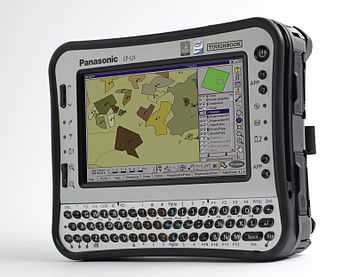Rugged computer

A rugged (or ruggedized, but also ruggedised) computer is a computer specifically designed to operate reliably in harsh usage environments and conditions, such as strong vibrations, extreme temperatures and wet or dusty conditions.[1] They are designed from inception for the type of rough use typified by these conditions, not just in the external housing but in the internal components and cooling arrangements as well.[2] In general, ruggedized and hardened computers share the same design robustness and frequently these terms are interchangeable.[3]
Typical end-user environments for rugged laptops, tablet PCs and PDAs are public safety, field sales, field service, manufacturing, retail, healthcare, transportation/distribution[4] and the military. They are used in the agricultural industries and by individuals for recreational activities, as well, such as hunting or geocaching.
Construction

Virtually all rugged computers share an underlying design philosophy of providing a controlled environment for the installed electronics. The electronic components themselves may be selected for their ability to withstand higher and lower operating temperatures than typical commercial components.
They incorporate features such as fully sealed keyboards to protect against intrusion by dust or liquids, and scratch-resistant screens that are readable in direct sunlight.[5]
Rugged units are more expensive in terms of annualized hardware costs. However, one research study found that in environments where rugged computers are commonly used, total cost of ownership was 36 percent lower for rugged notebooks and 33 percent less for handhelds and PDAs, compared to conventional non-rugged versions. The lower overall cost is due to lower failure rates, the related impact on productivity, and other factors.[6]
Standards
- MIL-STD-810: a military standard, issued in 1962, which establishes a set of tests for determining equipment suitability to military operations. Often used as a reference in the commercial laptop industry.
- MIL-S-901: a military standard for shock which applies to equipment mounted on ships. Two levels apply. Grade A items are items which are essential to the safety and continued combat capability of the ship. Grade B items are items whose operation is not essential to the safety and combat capability of the ship but which could become a hazard to personnel, to Grade A items, or to the ship as a whole as a result of exposure to shock.[7] Qualification testing is performed on a barge floating in a pond where TNT is detonated at various distances and depths in the pond to impart shock to the barges.
- IEEE 1156.1-1993 IEEE Standard Microcomputer Environmental Specifications for Computer Modules
- IEEE 1613 Computers in electrical substations used to concentrate data or communicate with SCADA systems follow IEEE 1613 "Standard Environmental and Testing Requirements for Communications Networking Devices in Electric Power Substations."
- IP (Ingress Protection): see IP Code
- IS (Intrinsic Safety): see Intrinsic safety
- TEMPEST: see Tempest (codename)
- ATEX (Potentially Explosive Atmospheres): see Equipment and protective systems intended for use in potentially explosive atmospheres
- NEMA (National Electrical Manufacturers Association)
- IK Code (Also known as EN50102) see EN 50102
- European standard EN 50155, "Railway Applications—Electronic Equipment Used On Rolling Stock", provides an example of a tough non-military specification. It extends operating temperature range (−25 – +70 °C), resistance to humidity, shocks, vibrations, radiation - encountered in vehicle or airborne installations.
Wireless connectivity
Wireless capability is a key requirement for most enterprise mobility applications, and it has been reported that wireless-transmission failure rates are three times higher for non-rugged notebooks compared to rugged units. This difference is attributed to the greater experience of rugged-notebook vendors at integrating multiple radios into their products. Each transmission failure leads to five to ten minutes in lost productivity as the user has to re-login to the company network through a VPN.[6]
Since enterprises are turning to cellular networks to enable full-time connectivity for their users,[8] major vendors of rugged computers offer both built-in wireless LAN and wireless WAN capabilities,[6][9][10][11] and partner with cellular carriers as part of their offerings.[12][13] During the handoff between the various wireless LAN and wireless WAN connections, a mobile VPN allows the connection to persist, creating an always-connected infrastructure that is simpler for the user and eliminates application crashes and data loss.[14]
See also
- Category:Avionics computers
- List of emerging technologies
- Industrial PC
- Military computers
- Mobile computer
- Portable computer
- 19-inch rack
References
| Wikimedia Commons has media related to Rugged laptops. |
- ↑ Rugged laptop computer for use in military ground vehicles and helicopters offered by General Dynamics Itronix - Military & Aerospace Electronics
- ↑ What you need to know before purchasing a rugged mobile computer, LXE, 2004.
- ↑ Hardened Laptops: A New Meaning Of Extreme. eweek.com, March 1st, 2004. Retrieved 10-2-2013.
- ↑ Supply Chain Management. Panasonic.com. Retrieved 10-2-2013.
- ↑ How ruggedness reduces TCO for mobile computers, VDC Research, 2009.
- ↑ 6.0 6.1 6.2 TCO Insights on Rugged Mobile Computers, VDC Research, 2007.
- ↑
- ↑ Next Generation Rugged Handheld Device Requirements, VDC Research, 2011.
- ↑ Rugged Laptops - Toughbook Mobile Computer Product Comparison
- ↑ Wireless Technical Info - Official Panasonic Toughbook Computers
- ↑ Rugged Notebook Computers with Integrated Wireless and GPS from General Dynamics Itronix, "Wireless Capability by Product"
- ↑ Wireless Computer Partners - Official Panasonic Toughbook Computers
- ↑ General Dynamics Itronix Wireless Activation Capabilities
- ↑ General Dynamics Itronix Mobility XE Overview Page